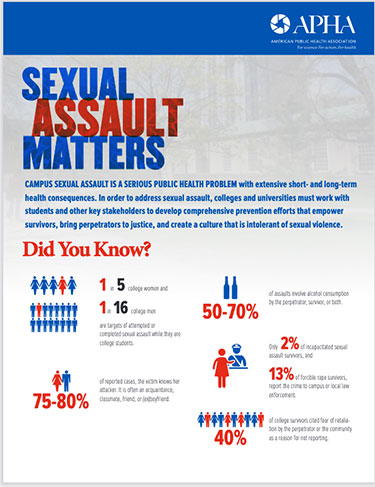General
Combatting sexual assault on college campuses
Reducing the risk of sexual assault on college campuses depends on students having a strong role in prevention and awareness programs, according to presenters at the Annual Meeting session, “Building a Safer Campus: Addressing Campus Sexual Assault Prevention Through a Public Health Lens.”
During the session, presenters from five state teams of the Campus Sexual Assault Action Planning Program highlighted their efforts to make their campuses safer. The program, developed by APHA in partnership with the Centers for Disease Control and Prevention, aims to build the capacity of public health workers to address campus sexual assault with a focus on primary prevention and partners with university stakeholders to create, implement and evaluate strategies.
 “We’re not leaving anyone out — we’re closing all the gaps on campus as best as we can,” said Jasmine Taylor, program coordinator for Zero Tolerance for Violence Against Women at Tougaloo College in Mississippi. Taylor explained the program’s goal of allowing students an open floor to express their trauma. The program encourages self-care, supports mental health and involves student leaders in all aspects of their program.
“We’re not leaving anyone out — we’re closing all the gaps on campus as best as we can,” said Jasmine Taylor, program coordinator for Zero Tolerance for Violence Against Women at Tougaloo College in Mississippi. Taylor explained the program’s goal of allowing students an open floor to express their trauma. The program encourages self-care, supports mental health and involves student leaders in all aspects of their program.
Presenters also emphasized developing a relatable educational curriculum.
“When students feel seen and represented in the content, students just engage more with the content itself,” said presenter Sven Rundman, assistant director of prevention education at the University of California-Santa Barbara. Their program equipped student leaders with resources from educational workshops to pass on to their respective campus organizations.
At California State University-Fullerton, organizers focused on campus fraternities by implementing the ‘BRO Code’ program, which was designed to facilitate a “culture shift in these hyper-masculine spaces,” explained Alisa Flowers, director of the university’s WoMen's and Adult Reentry Center. BRO Code members held events with local organizations and focused on preventing sexual assault through bystander intervention efforts.
Overall, institutions participating in the APHA-CDC program found that students felt most seen when they interacted directly with local organizations and peers.
“We have found that the peer-to-peer aspect of it was the most important to breaking the social norms,” said Jessica Roueche, coordinator of the Student Involvement & Leadership Program at Utah State University. “Social connectedness is important.”
Help bring awareness to the public health problem of campus sexual assault by sharing APHA’s infographic.


